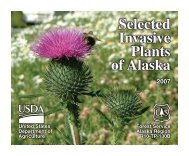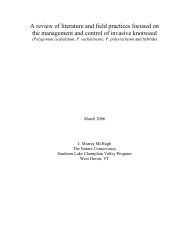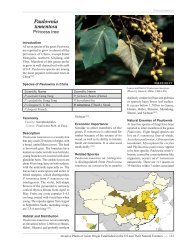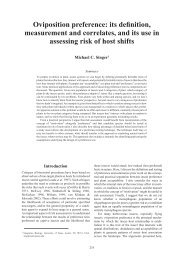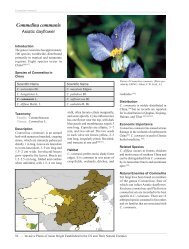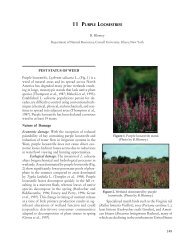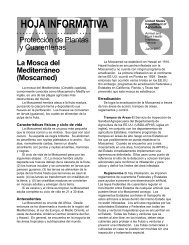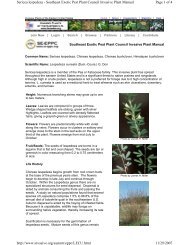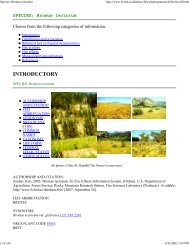Lonicera spp.
Lonicera spp.
Lonicera spp.
Create successful ePaper yourself
Turn your PDF publications into a flip-book with our unique Google optimized e-Paper software.
<strong>Lonicera</strong> <strong>spp</strong>.<br />
<strong>Lonicera</strong> <strong>spp</strong>.<br />
Honeysuckle<br />
Introduction<br />
The genus <strong>Lonicera</strong> contains more than<br />
200 species worldwide and is distributed<br />
in temperate and subtropical regions<br />
of North America, Europe, North<br />
Africa, and Asia. Most of the species<br />
are small trees or shrubs. Ninety-eight<br />
species of <strong>Lonicera</strong> are reported from<br />
China; it is distributed nationwide<br />
with considerable species diversity<br />
in southwestern China [176] .<br />
Species of <strong>Lonicera</strong> in China [24]<br />
(NEXT PAGE)<br />
I. <strong>Lonicera</strong> fragrantissima<br />
fragrant honeysuckle<br />
Taxonomy<br />
Family: Caprifoliaceae<br />
Genus: <strong>Lonicera</strong> L.<br />
Description<br />
<strong>Lonicera</strong> fragrantissima is a subevergreen<br />
or deciduous shrub that<br />
can grow 2 m tall. The leaves may<br />
be thick and papery or somewhat<br />
leathery, with noticeable variations<br />
in shape, ranging from obovate to<br />
elliptic, ovate, or oblong. Leaf length<br />
is 3-7 cm, with a tapered or retuse apex<br />
and a round or broadly cuneate base.<br />
Flowers with red to light-red labiate<br />
corolla are produced in the axils of young<br />
shoots appearing from mid-February<br />
to April. The oblong, showy, red fruits<br />
are about 1 cm long and appear from<br />
late April to May. The rough brown<br />
seeds are oblong and about 3.5 mm<br />
in length [176] .<br />
Habitat<br />
L. fragrantissima occurs in scrub land<br />
at elevations of 200 –700 m [176] .<br />
Distribution<br />
L. fragrantissima is indigenous<br />
to Anhui, Henan, Hubei, Jiangxi,<br />
Shanxi, and Zhejiang provinces [176] ,<br />
and is also cultivated in some cities,<br />
including Shanghai, Hangzhou in<br />
Zhejiang, Wuhan in Hubei, and Taian<br />
in Shandong [8] .<br />
Growth habit of <strong>Lonicera</strong> japonica. (Photo by<br />
James R. Allison, GA-DNR.)<br />
Economic Importance<br />
Honeysuckle is cultivated in private<br />
gardens and in cities as an ornamental<br />
because of its large, fragrant flowers<br />
and brilliant red fruits [71] .<br />
Related Species<br />
There are two subspecies of <strong>Lonicera</strong><br />
fragrantissima in China. <strong>Lonicera</strong><br />
fragrantissima subsp. standishii (Carr.)<br />
Hsu et H.J. Wang occurs on sunny<br />
forested slopes and along ravines, in<br />
Anhui, Gansu, Guizhou, Henan, Hubei,<br />
Hunan, Jiangxi, Shaanxi, Sichuan, and<br />
Zhejiang provinces (at elevations of<br />
100–2,000 m). The other subspecies,<br />
L. fragrantissima subsp. phyllocarpa<br />
(Maxim.) Hsu et H. J. Wang, grows on<br />
slopes, in valleys, and in riparian areas,<br />
in Anhui, Hebei, Henan, Jiangsu, Shaanxi,<br />
and Shanxi provinces (at elevations of<br />
480–2,000 m) [176] .<br />
II. <strong>Lonicera</strong> japonica<br />
Japanese honeysuckle<br />
Taxonomy<br />
Family: Caprifoliaceae<br />
Genus: <strong>Lonicera</strong> L.<br />
Description<br />
<strong>Lonicera</strong> japonica is a semi-evergreen<br />
vine with pubescent stems. The papery<br />
leaves are 3-5 cm long and covered<br />
with coarse hairs. The leaf blades are<br />
ovate, with rounded or subcordate<br />
bases, apices are acute or acuminate,<br />
and slightly notched. A distinguishing<br />
98 — Invasive Plants of Asian Origin Established in the US and Their Natural Enemies
<strong>Lonicera</strong> <strong>spp</strong>.<br />
Leaves and flowers of <strong>Lonicera</strong> japonica.<br />
(Photo by Jil M. Swearingen, USDI-NPS.)<br />
feature separating L. japonica from<br />
related species is the upper leaf surface,<br />
which is greener than the underside.<br />
Growing in the leaf axils, the pubescent<br />
flowers, appearing from April to June,<br />
have conspicuous leaf-like bracts and<br />
white corollas, and appearing from<br />
April to June. The peduncle and leaf<br />
petiole are similar in size. The shiny,<br />
dark blue fruits are round, 6-7 mm in<br />
diameter, and mature from October to<br />
November [176] .<br />
Habitat<br />
<strong>Lonicera</strong> japonica occurs among<br />
shrubs, along slopes, roadsides, in<br />
sparse forests, hedges, and on gravel<br />
banks at elevations up to 1500 m [176] .<br />
Distribution<br />
L. japonica is distributed nationwide in<br />
China: however, it is not native to Hainan,<br />
Heilongjiang, Inner Mongolia, Ningxia,<br />
Qinghai, Xinjiang, or Tibet [176] .<br />
Economic Importance<br />
Extracts of chlorogenic acid and<br />
isochlorogenic acid are used medicinally<br />
in China [176] .<br />
Related Species<br />
<strong>Lonicera</strong> japonica var. chinensis (Wats.)<br />
Bak. occurs in Anhui at elevations of up<br />
to 800 m. It is also cultivated in Jiangsu,<br />
Jiangxi, Yunnan, and Zhejiang [176] .<br />
III. <strong>Lonicera</strong> maackii<br />
Amur honeysuckle<br />
Taxonomy<br />
Family: Caprifoliaceae<br />
Genus: <strong>Lonicera</strong> L.<br />
Description<br />
<strong>Lonicera</strong> maackii (Rupr.) Maxim is<br />
a deciduous shrub that can reach a<br />
height of 6 m and a stem diameter<br />
of 10 cm. The entire plant is covered<br />
with glandular hairs. Winter buds are<br />
small, ovoid, and covered with more<br />
than five pairs of scales. Papery leaves<br />
are ovate-elliptic to ovate-lanceolate, 5-8<br />
cm long with acuminate to narrowly<br />
acuminate apices and a rounded or<br />
wedge-shaped leaf bases. The petiole<br />
is 2-5 mm cm long and is longer than<br />
the 1-2 mm long peduncle. White<br />
to yellow, fragrant, axillary flowers<br />
with labiate corollas and a linear to<br />
lanceolate bracts appear from May<br />
to June. Fruits are globular, dark-red,<br />
5-6 mm in diameter, and mature from<br />
August to October [176] .<br />
Habitat<br />
L. maackii occurs in riparian areas at the<br />
edge of forests at elevations of 1,800<br />
m (3,000 m in some areas of Yunnan<br />
and Tibet) [176] .<br />
Fruits of <strong>Lonicera</strong> maackii. (Photo by Chuck<br />
Bargeron, UGA.)<br />
Invasive Plants of Asian Origin Established in the US and Their Natural Enemies — 99
<strong>Lonicera</strong> <strong>spp</strong>.<br />
Natural Enemies of <strong>Lonicera</strong><br />
Twenty-one fungi have been reported<br />
to damage <strong>Lonicera</strong>. Six species are<br />
found on L. japonica; four on <strong>Lonicera</strong><br />
maackii, and one on fragrant honeysuckle.<br />
Microsphaera lonicerae can damage<br />
both Japanese and fragrant honeysuckle.<br />
Puccinia festucae Plowright is found on<br />
both Japanese and amur honeysuckle.<br />
Forty-four arthropod species have been<br />
found on <strong>Lonicera</strong> <strong>spp</strong>., of which 23<br />
species attack Japanese honeysuckle<br />
and four damage amur honeysuckle.<br />
Approximately 20 insect species<br />
have a narrow H. R. within the genus<br />
<strong>Lonicera</strong>.<br />
Distribution<br />
L. maackii is distributed throughout<br />
Anhui, Gansu, Guizhou, Hebei,<br />
Heilongjiang, Henan, Hubei, Hunan,<br />
Jiangsu, Jiangxi [84] , Jilin, Liaoning,<br />
Ningxia [116] , Shaanxi, Shandong, Shanxi,<br />
Sichuan, Yunnan, and Zhejiang [176] , and<br />
recorded as L. maackii podocarpa<br />
Franch. ex Rehd in Tibet.<br />
Economic Importance<br />
Essential oil of honeysuckle is<br />
extracted from the flower of Amur<br />
honeysuckle. The stem is a source of<br />
artificial cotton [176] .<br />
Related Species<br />
One variety of Amur honeysuckle, L.<br />
maackii var. erubescens Rhed., grows<br />
on hillside slopes in Anhui, Gansu,<br />
Jiangsu, and Henan [176] .<br />
IV. <strong>Lonicera</strong> tatarica<br />
Tartarian honeysuckle<br />
Taxonomy<br />
Family: Caprifoliaceae<br />
Genus: <strong>Lonicera</strong> L.<br />
Description<br />
<strong>Lonicera</strong> tatarica is a deciduous shrub<br />
that grows 3 m in height. The whole<br />
plant is nearly glabrous. The winter<br />
buds have approximately four pairs<br />
of scales. Leaves are papery, ovate,<br />
oblong or ovate-oblong, 2-5 cm in<br />
length, with a tapering apices and<br />
rounded to subcordate bases. Leaf<br />
margins are covered with coarse hairs.<br />
Flowers are produced from May to June.<br />
Bracts are linear lanceolate or linear<br />
oblanceolate, equal to or longer than<br />
the length of the calyx tube. Corollas<br />
are pink or white, 1.5 cm long, and<br />
labiate. Fruits are red, globular, 5-6<br />
mm in diameter and mature from July<br />
to August [176] .<br />
Habitat<br />
L. tatarica occurs on rocky slopes,<br />
forest edges, and scrubland in ravines<br />
at elevations of 900–1,600 m.<br />
Distribution<br />
<strong>Lonicera</strong> tatarica is native to northern<br />
Xinjiang. It is cultivated in Hebei [18] ,<br />
Heilongjiang, Liaoning [176] , and<br />
Shanxi .<br />
Colorful flowers of <strong>Lonicera</strong> tatarica. (Photo<br />
by Patrick Breen, Oregon State University.)<br />
Related Species<br />
L. tatarica L. var. micrantha Trautv.<br />
occurs in Xinjiang, on riverbanks at<br />
700-800 m elevation [176] .<br />
100 — Invasive Plants of Asian Origin Established in the US and Their Natural Enemies
<strong>Lonicera</strong> <strong>spp</strong>.<br />
Species of <strong>Lonicera</strong> in China [24]<br />
Scientific Name Scientific Name Scientific Name<br />
L. acuminata Wall. L. nervosa Maxim. L. altmannii Regel et Schmalh.<br />
L. nigra L. L. angustilfolia Wall. ex DC. L. nubium (Hand.-Mazz.) Hand.-Mazz.<br />
L. anisocalyx Rehd. L. oreodoxa H. Smith ex Rehd. L. bourtnei Hemsl.<br />
L. pampaninii Lévl. L. brevisepala Hsu et H. J. Wang L. pileata Oliv.<br />
L. buchananii Lace L. praeflorens Batal. L. buddleioides Hsu et S. C. Cheng<br />
L. prostrata Rehd. L. caerulea L. L. retusa Franch.<br />
L. calcarata Hemsl. L. rhytidophylla Hand.-Mazz.<br />
L. calvescens (Chun et How) Hsu et H. J.<br />
Wang<br />
L. rupicola Hook. f. et Thoms. L. carnosifolia C. Y. Wu ex Hsu et H. J. Wang L. ruprechtiana Regel<br />
L. chrysantha Turcz. L. semenovii Regel L. ciliosissima C. Y. Wu ex Hsu et H. J. Wang<br />
L. sempervirens L. L. cinerea Pojark. L. setifera Franch.<br />
L. confusa (Sweet) DC. L. similis Hemsl. L. crassifolia Batal.<br />
L. stephanocarpa Franch. L. cyanocarpa Franch. L. subaequalis Rehd.<br />
L. dasystyla Rehd. L. subhispida Nakai L. elisae Franch.<br />
L. sublabiata Hsu et H. J. Wang L. fargesii Franch. L. tatarica L.<br />
L. ferdinandii Franch. L. tatarinowii Maxim. L. ferruginea Rehd.<br />
L. tragophylla Hemsl. L. fragilis Lévl. L. trichosantha Bur. et Franch.<br />
L. fragrantissima Lindl. et Paxt. L. trichosepala (Rehd.) Hsu L. fulvotomentösa Hsu et S.C. Cheng<br />
L. tubliflora Rehd. L. graebneri Rehd. L. virgultorum W. W. Smith<br />
L. gynochlamydea Hemsl. L. yunnanensis Franch. L. hildebrandiana Coil. et Hemsl.<br />
L. alberti Regel L. hispida Pall. ex Roem. et Schult. L. codonantha Rehd.<br />
L. humilis Kar. et Kir. L. hemsleyana (O. Ktze.) Rehd. L. hypoglauca Miq.<br />
L. heterophylla Decne. L. hypoleuca Decne. L. jilongensis Hsu et H.J. Wang<br />
L. inconspicua Batal. L. litangensis Batal. L. inodora W. W. Smith<br />
L. minuta Batal. L. japonica Thunb. L. minutifolia Kitam.<br />
L. kansuensis (Batal. ex Rehd.)<br />
Pojark.<br />
L. modesta Rehd. L. kawakamii (Hayata) Masam.<br />
L. oblata Hao ex Hsu et H.J. Wang L. lanceolata Wall. L. oiwakensis Hayata<br />
L. ligustrina Wall. L. saccata Rehd. L. longilflora (Lindl.) DC.<br />
L. schneideriana Rehd. L. longituba H. T. Chang ex Hsu et H. J. Wang L. serreana Hand.-Mazz.<br />
L. maackii (Rupr.) Maxim. L. spinosa Jacq. ex Walp. L. macrantha (D. Don) Spreng.<br />
L. szechuanica Batal. L. macranthoides Hand.-Mazz. L. alpeiensis Hsu et H.J.Wang<br />
L. maximowiczii (Rupr.) Regel L. tangutica Maxlm. L. microphylla Wllld. ex Roem. et Schult.<br />
L. tomentella Hook.f. et Thoms. L. mucronata Rehd. L. trichogyne Rehd.<br />
L. myrtilllus Hook. f. et Thoms. L. webbiana Wall. ex DC.<br />
Invasive Plants of Asian Origin Established in the US and Their Natural Enemies — 101
<strong>Lonicera</strong> <strong>spp</strong>.<br />
Fungi<br />
Phylum Family Species H. R. Ref.<br />
Ascomycota<br />
Basidiomycota<br />
Erysiphaceae<br />
Meliolaceae<br />
Microsphaera dipeltae Y.N. Yu & Y.Q. Lai oo 22<br />
Microsphaera erlangshanensis Y.N. Yu mo 22<br />
Microsphaera lonicerae (DC.) G. Winter o* ‡ 22<br />
Microsphaera vanbruntiana W.R. Gerard po 22<br />
Asteridiella lonicerae (W. Yamam.) Hosag.<br />
o* 62<br />
Phyllachoraceae Phyllachora xylostei (Fr.) Fuckel mo 23<br />
Rhytismataceae Rhytisma lonicericola Henn. o † 23<br />
Hymenochaetaceae Phellinus setulosus (Lloyd) Imazeki po 23<br />
Polyporaceae Fomes calcitratus (Berk. & M.A. Curtis) Cooke oo 23<br />
Pucciniaceae<br />
Puccinia festucae Plowr.<br />
oo<br />
23 I<br />
* 22<br />
p* † 23<br />
Puccinia longirostris Kom. oo 23<br />
Anamorphic Ascomycetes Rhabdospora decipiens (Berk. & M.A. Curtis) Sacc. mo 23<br />
Anamorphic Discosphaerina Kabatia latemarensis Bubák oo 23<br />
Anamorphic Guignardia Phyllosticta caprifolii (Opiz) Sacc. mo 23<br />
Anamorphic Lophodermium Leptostroma lonicericola Rabenh. oo 23 II<br />
Anamorphic Mycosphaerella<br />
Cercospora lonicericola W. Yamam. m* 23<br />
Cercospora periclymeni G. Winter o* 23<br />
Septoria lonicerae-maackii Miura m † 23<br />
Anamorphic Mycosphaerellaceae Ascochyta tenerrima Sacc. & Roum. m* 23<br />
Anamorphic Rhytisma Melasmia lonicerae Jacz. o † 23<br />
* attacks <strong>Lonicera</strong> japonica<br />
† attacks <strong>Lonicera</strong> maackii<br />
‡ attacks <strong>Lonicera</strong> tartarica<br />
I<br />
Recorded as Irenina lonicerae Yamam<br />
II<br />
Recorded as Leptostroma lonicericolum Rabenh.<br />
Arthropods<br />
Order Family Species H. R. Ref.<br />
Acariformes Rhyncaphytoptidae Rhyncaphytoptus lonicerae Kuang et Zhuo m† 83<br />
Coleoptera<br />
Hemiptera<br />
Asias halodendri (Pallas) p* 65<br />
Cerambycidae<br />
m* 85<br />
Xylotrechus grayii (White)<br />
p* 140<br />
Liroetis loniceris Jiang oo 140<br />
Pseudoliroetis fulvipennis (Jacoby) p* 85<br />
Chrysomelidae<br />
oo 140<br />
Trachyaphthona obscura (Jacoby)<br />
oo 158<br />
oo 185<br />
Zangia signata Jiang po 140<br />
Acanthosomatidae Platacantha forfex (Dallas) po 193<br />
Pentatomidae Piezodorus lituratus (Fabricius) p* 193<br />
102 — Invasive Plants of Asian Origin Established in the US and Their Natural Enemies
<strong>Lonicera</strong> <strong>spp</strong>.<br />
Amphicercidus sinilonicericola Zhang<br />
m* 85<br />
m* 189<br />
Microlophium carnosa (Buckton) po 140<br />
Neorhopalomyzus lonicericola (Takahashi) m* 158<br />
Neotoxoptera oliveri (Essig) m* 100<br />
p† 100<br />
Aphididae<br />
Semiaphis heraclei (Takahashi)<br />
p†* 158<br />
Homoptera<br />
p†* 189<br />
o†* 65<br />
Trichosiphonaphis lonicerae (Uye)<br />
oo 85<br />
m† 100<br />
Tuberocephalus sp. m* 85<br />
Membracidae Telingana scutellata China po 140<br />
Pemphigidae Prociphilus ligustrifoliae (Tseng et Tao) mo 189<br />
Hymenoptera Argidae Arge similis (Vollenhoven) p* 65<br />
Hyphantria cunea (Drury) p† 41<br />
Arctiidae<br />
p* 40<br />
Pericallia matronula (Linnaeus)<br />
p* 41<br />
Angerona glandinaria Motschulsky po 138<br />
Ourapteryx sambucaria Linnaeus p* 138<br />
Geometridae<br />
m* 85<br />
Somatina indicataria Walker<br />
p* 138<br />
Trichopteryx polycommata (Denis et Schiffermüller) p* 177<br />
Lymantriidae Porthesia similis (Fueszly)<br />
p* 65<br />
p* 198<br />
Conistra ligula (Esper) po 12<br />
Noctuidae<br />
Crino satura (Schiffermüller) po 209<br />
Polia thalathina (Rottemberg) po 12<br />
Limenitis camilla (Linnaeus) p* 203<br />
Limenitis moltrechti Kardakoff p* 203<br />
Lepidoptera Nymphalidae Limenitis sulpitia (Cramer)<br />
p* 158<br />
po 203<br />
Parasarpa dudu (Westwood)<br />
p* 203<br />
po 203<br />
Saturniidae Antheraea yamamai Guerin-Meneville po 207<br />
p* 65<br />
Sphingidae<br />
Haemorrhagia staudingeri staudingeri (Leech)<br />
m* 206<br />
m* 206<br />
m* 208<br />
Adoxophyes orana Fischer von Röslerstamm<br />
p* 65<br />
p* 113<br />
Archips xylosteana (Linnaeus) p* 113<br />
Tortricidae<br />
Choristoneura diversana (Hübner) p* 113<br />
Clepsis rurinana (Linnaeus) p* 65<br />
Clepsis semialbana (Guenée) p* 113<br />
Lozotaenia forsterana (Fabricius) p* 113<br />
Pandemis dumetana Treitshke po 141<br />
Thysanoptera Thripidae Frankliniella intonsa (Trybom) po 56<br />
* attacks <strong>Lonicera</strong> japonica<br />
† attacks <strong>Lonicera</strong> maackii<br />
Invasive Plants of Asian Origin Established in the US and Their Natural Enemies — 103




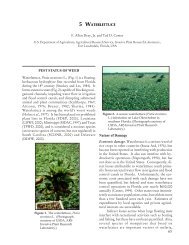
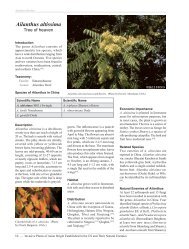
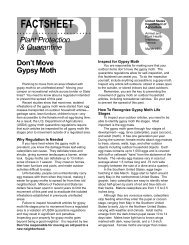
![A Guide to the Control and Management of Invasive Phragmites [PDF]](https://img.yumpu.com/27321025/1/190x190/a-guide-to-the-control-and-management-of-invasive-phragmites-pdf.jpg?quality=85)
